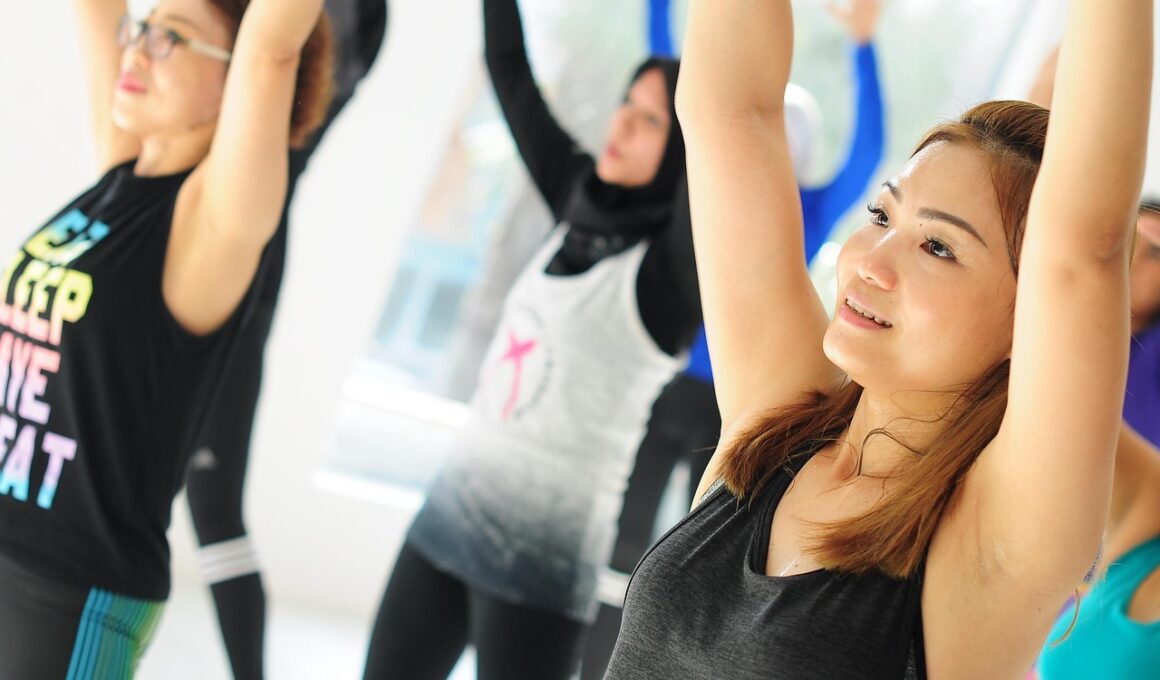How Group Fitness Classes Support Blood Pressure Management
Managing blood pressure effectively is crucial for overall cardiovascular health. Engaging in regular exercise, particularly through group fitness classes, offers significant benefits in controlling hypertension. These classes, ranging from spin to Zumba, provide not only physical activity but also a supportive community. Exercising with others increases motivation and accountability, driving individuals to commit to consistent workouts. This consistency plays a key role in maintaining a healthy blood pressure. Also, group fitness classes often incorporate structured programs overseen by trained instructors who can provide valuable modifications to suit different fitness levels. By ensuring exercises are performed safely, instructors can help participants avoid injuries while effectively managing their blood pressure. Moreover, these classes can be a source of social interaction, fostering bonds that enhance emotional well-being. Research indicates that a positive mindset can contribute to lower stress levels, which is beneficial for blood pressure management. Hence, the social environment of group fitness classes can lead to improved adherence to exercise regimes, thus supporting cardiovascular health while directly influencing hypertension outcomes.
Participating in group fitness classes offers a variety of exercises that can cater to individual needs. Activities such as yoga and Pilates focus on flexibility and core strength, while high-intensity interval training (HIIT) might be offered for those seeking a more vigorous workout. Each style of exercise impacts the cardiovascular system differently, helping to promote heart health and stabilize blood pressure. According to studies, engaging in moderate physical activity facilitates improved blood flow and enhances heart function. A well-rounded fitness routine that includes cardiovascular, strength, and flexibility training can produce synergistic effects on blood pressure. Group fitness also fosters a friendly competition, where individuals strive to push one another towards reaching personal fitness goals. This sense of camaraderie encourages individuals to engage in activities that they may not do alone. The environment can often enhance enjoyment, transforming the perception of exercise from a chore to an engaging experience. With music, lively instructors, and a sense of community, individuals are more likely to continue attending classes regularly, further benefiting blood pressure control and overall health.
Holistic Approach to Health
A key aspect of managing blood pressure through group fitness is understanding its holistic approach to health. Regular participation not only targets physical fitness but also addresses mental and emotional health. Stress is a recognized contributor to high blood pressure; thus, activities in group classes that incorporate relaxation techniques, such as stretching or mindfulness meditation, foster stress reduction. Engaging the body in rhythmic movement releases endorphins, enhancing mood and decreasing anxiety. Additionally, group dynamics create an environment where individuals feel supported and empowered by others sharing similar health goals. This camaraderie can be pivotal for enhancing motivation and adherence to exercise programs. Furthermore, instructors often provide education about health, nutrition, and lifestyle changes beneficial for managing blood pressure. This comprehensive approach ensures that individuals have the tools and knowledge needed to make sustainable changes. Therefore, group fitness classes become a multi-dimensional platform for promoting a healthy lifestyle, benefiting both body and mind. Such classes become integral in building a solid foundation for long-term cardiovascular fitness and effective hypertension management through synchronized physical activity and supportive interactions.
Group fitness classes can be particularly advantageous for diverse populations, including seniors, individuals with chronic health conditions, or those new to fitness. Specialized classes tailored to different skill levels can promote safe engagement in exercise without the fear of injury. For example, low-impact classes can reduce strain on joints while still providing effective aerobic workouts that contribute to cardiovascular health. Moreover, these classes are often designed to include warm-ups and cool-downs, essential for anyone managing blood pressure. The social aspect of exercising with others can reduce feelings of isolation, which may further help in decreasing stress levels. Instructors trained in specific health concerns can monitor participants closely and adjust exercises dynamically to ensure both safety and effectiveness. This level of care and consideration enables individuals to navigate fitness in a manner that feels both achievable and supportive. Research shows that such positive interactions lead to better health outcomes over time. With resources available and fellow participants to lean on for encouragement, attendees are likely to enjoy consistent progress toward their health objectives, including effective blood pressure management.
The Importance of Consistency
Consistency is vital in achieving tangible results in managing blood pressure through exercise. Group fitness classes encourage participants to establish regular workout schedules as classes typically occur multiple times per week. This routine fosters a healthier lifestyle, making exercise a non-negotiable part of daily life. With consistent attendance, individuals can track their progress, measuring improvements in endurance and strength, which correlate positively with blood pressure control. In addition, instructors often incorporate challenges or milestones, motivating participants to push themselves further while monitoring their blood pressure levels. Metrics like heart rate or perceived exertion may be shared during sessions, promoting an awareness of individual health. Such awareness can empower individuals to make informed decisions about their physical activity levels on non-class days. Furthermore, establishing a consistent fitness regimen creates measurable health progress, reinforcing individual confidence and competence in managing blood pressure. Ultimately, when individuals witness positive changes both physically and emotionally, they are more likely to remain committed to their fitness journey. The communal experience in group classes helps to foster this level of dedication much more effectively than solitary workouts.
In addition to physical activity, nutrition plays a significant role in supporting healthy blood pressure levels. Many group fitness classes offer additional resources such as workshops or nutritional classes. These programs might discuss the importance of a balanced diet, focusing on whole foods rich in nutrients, such as fruits, vegetables, and whole grains. Instructors may provide guidelines on assessing personal dietary habits while encouraging participants to adopt healthier eating patterns in conjunction with their physical activities. This holistic approach can lead to more sustainable long-term changes that support well-being and blood pressure control. Participants can learn about meal planning, mindful eating practices, and the impact of sodium on hypertension. Implementing these dietary recommendations while actively engaging in group exercise creates a synergistic effect on overall health and well-being. When individuals view their fitness journey as more than just exercise, they become more invested in making choices that support their health goals. Together, these elements help weave a lifestyle where exercise and nutrition complement one another, facilitating the management of blood pressure and enhancing cardiovascular fitness in a collaborative manner.
Creating Lifelong Habits
Adopting a regular fitness routine through group classes can significantly influence long-term habits beneficial for blood pressure management. As individuals become acclimated to the structure of group sessions, they begin to recognize the value of maintaining these practices even outside the classroom. The shared experiences during class foster connections and accountability, promoting retention and adherence to physical activity. Additionally, participants often develop friendships that extend beyond fitness classes, creating social networks that enhance happiness and motivation. These social connections can serve as vital support systems in achieving health goals. Furthermore, by embracing these positive habits, individuals become more inclined to explore other aspects of their wellness, such as nutrition and emotional health. Instructors can guide the transition from class-based activity to self-directed workouts, gradually empowering individuals to take ownership of their fitness journey. When individuals feel empowered, they are less likely to revert to sedentary behaviors and more likely to embrace active lifestyles. Therefore, group fitness classes not only assist in managing blood pressure but also instill patterns that become lifelong habits, ensuring long-term cardiovascular health and quality of life.
Conclusively, group fitness classes serve as effective platforms for managing blood pressure through structured exercise and emotional support. They promote a sense of community while addressing the multifaceted needs of participants. By engaging in regular physical activity, individuals can achieve cardiovascular fitness and experience positive results in hypertension control. The variety of classes available ensures that there is something for everyone, thus encouraging participation regardless of fitness level. Furthermore, the benefits extend beyond mere physical fitness, incorporating holistic wellness aspects that address mental and emotional health. With positive reinforcement from instructors and fellow participants, attendees can develop motivation and accountability. A structured approach that includes exercise and nutrition education equips individuals with tools for healthier lifestyles. Ultimately, these classes foster a commitment to long-term health, helping to create environments conducive to sustaining positive behavior changes. Community support and consistent engagement are crucial for successful blood pressure management, promoting well-being over a lifetime. Group fitness classes encapsulate the essence of teamwork and personal empowerment in achieving cardiac health, proving they are essential tools in the fight against hypertension.


